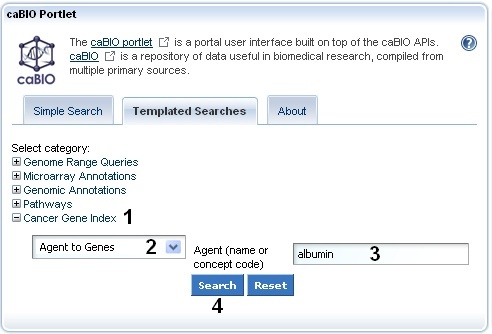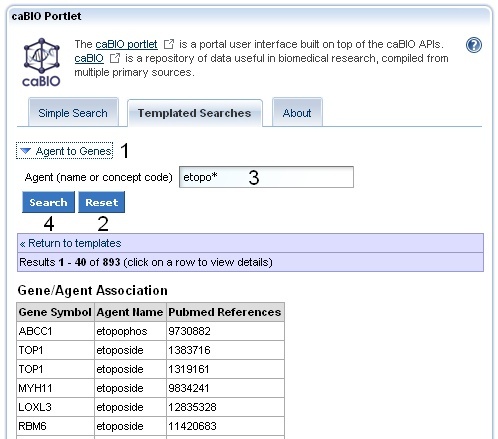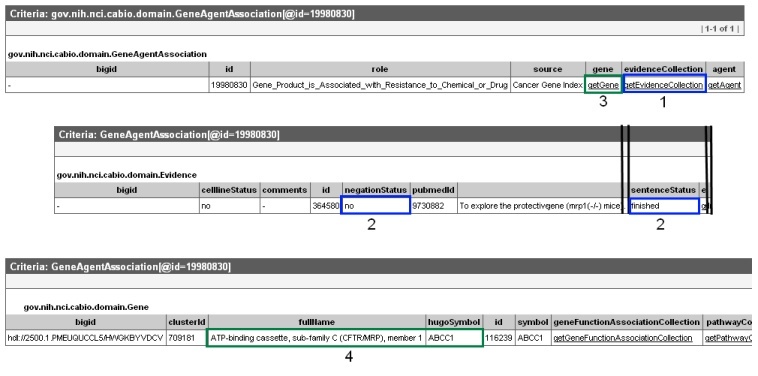To Print the Guide
We recommend you print one wiki page of the guide at a time. To do this, click the printer icon at the top right of the page; then from the browser File menu, choose Print. Printing multiple pages at one time is more complex. For instructions, refer to How do I print multiple pages?.
Selecting a Compound Search Term
The caBIO Portlet Templated Search tool allows end users to specify case-insensitive keyword queries or to search for genes that match a specific compound concept term or concept code from the NCI Thesaurus. These keywords, terms or codes must match exact compound terms in the Cancer Gene Index.
Note
Although the Cancer Gene Index refers to pharmacological substances as "compounds," caBIO and the NCI Thesaurus refers to the concept as "agents."
If you would like to use keywords to find genes that are associated with a compound, either alone or in combination with another substance (e.g., as any substance containing "etoposide"), as opposed to a specific compound ("Etoposide Phosphate"), it is highly recommended that you use the * wild card character in your search terms (e.g., "etoposide*" or "*etoposide*"). This character will match zero or more characters. For example, a search for "etoposide" will return nearly 875 gene-agent pairs that are related to that exact term, whereas a search for "*etop*" returns nearly 900 gene-disease pairs, where genes match terms that include "etopophos," "etoposide" and "etoposide phosphate."
Warning
Not all brand names for pharmacological substances are included in the Cancer Gene Index.
If you would like to search for a specific compound (e.g., only for "Etoposide Phosphate"), it is highly recommended that you search the NCI Thesaurus for your desired term prior to querying the Templated Search tool. Navigate to the NCI Thesaurus web page and select the Contains radio button (1). Enter in one or more keywords (2, e.g. "etoposide"), and click the Search button (3). A list of all NCI Thesaurus terms that contain your keyword/s will be retrieved.
Note
If you do not find an appropriate term, try inserting a single question mark after your search term (e.g., "etopo?") to increase the number of retrieved terms.
If after trying these tips and using various keywords you still cannot find the term for which you were looking, click on the Contact Us link at the bottom of the web page for help (4).
Once you find your desired NCI Thesaurus term in the list of retrieved results, click on its name in order to navigate to its concept page. For searching caBIO, you may use the NCI Thesaurus Preferred Name (1), the NCI Thesaurus Code (2), or even one of the term's synonyms and abbreviations. The Preferred Name and NCI Thesaurus code are present both at the top of the concept page and within the Terms and Properties section of the web page.
Using Templated Search Tool to Retrieve Gene-Compound Concept Pairs
To search for Cancer Gene Index gene-compound data on the Templated Search page, click on the Cancer Gene Index Category node (1) and choose the Agent to Genes query option (2). Manually delete the suggested search term "albumin" (3), enter your compound term or concept code into the text box (e.g., "*etop*" or "etoposide"), and click the Search button (4).
The Agent to Genes query returns all of the genes that were associated in MEDLINE abstracts with your compound search term. These results are presented in table consisting of three columns which include: HUGO gene symbol, NCI Thesaurus agent term, and a PubMed identifier. Each row represents a piece of evidence (i.e. a sentence extracted from MEDLINE abstracts) supporting the gene-compound association.
Saving Your Search Results
At this time, you cannot download your search results. Instead, you must copy them into a text editor or spreadsheet.
If no genes are associated with your compound term, you will receive a "No results found" message.
Tip
If you have used your own search term, the Cancer Gene Index may use a different term for the same compound concept. Try using of the compound's generic name if you used the brand name, the "*" wild card character or a more general search term (e.g., "*etopo*" instead of "etoposide-fluorouracil").
If you have used the NCI Thesaurus to find a specific term or code and there is no typographical error in your query, the Cancer Gene Index does not contain genes associated with that compound term.
Validating Your Retrieved Gene-Agent Results
A fully-featured search tool would allow you to limit your searches to results that have been validated by the Cancer Gene Index project's human curators as being true gene-compound associations or that do not come from cell lines. Currently, however, the Templated Search does not allow such limits to be set. Thus, you must access to caBIO Object Graph Browser to manually check the validity of each of the retrieved records.
To perform these checks, click on any gene-compound result row in order to view its Gene-Disease Association information. Gene-Agent Assocation data includes the Gene Term, Gene Symbol, Agent Term, Agent Symbol, Sentence PubMed Identifier, Sentence Evidence, Evidence Code, and Role Code or Detail (1). Additional information on these items may be found in the Data, Metadata, and Annotations section.
Next, click on the Open this record in the caBIO Object Graph Browser at the bottom of the page (2).
This will open up a the Gene-Agent Assocation object in a new tab in your web browser. Click on the getEvidenceCollection link (3, green box) to open the full Evidence record, which contains all of the annotations made by the curator for that particular piece of evidence of a gene-compound association. Gene-compound associations with true relationships were validated as being true associations by human curators have a sentenceStatus set to "finished" and a negationStatus set to "no" (4, middle and right green boxes). If you wish to exclude data from cell lines, look for the celllineStatus to be "no" (4, left green box). Additional information on these items may be found in the Data, Metadata, and Annotations section.
Note
If you accidentally navigate to somewhere else in the caBIO Object Viewer and are confused, go back!
Once you have finished reviewing the gene-compound association in the caBIO Object Graph Browser, return to the caBIO Portlet web browser tab or window, and click the Return to Results link in blue to continue evaluating retrieved gene-compound pairs in the results table.
To search for genes associated with these additional compound concepts, return to your Templated Search results page if needed and click the Agent to Genes link (1), click the Reset button (2) or manually delete the search contents, enter additional search terms or concept codes (3), and click Search (4). If you would like to select a new query option, click Return to Templates (below 2 and 4).
Agent Ontologies
Although the NCI Thesaurus contains information about compound ontologies, the caBIO Templated Search does not currently allow you to leverage this hierarchical compound information. In the future, this feature may be implemented in this tool, but for now, you must searching the NCI Thesaurus for these ontological compound terms and perform a Templated search for each parent or child concept.
Agent Ontologies and the Cancer Gene Index
The Cancer Gene Index includes the NCI Thesaurus term "Pharmacologic Substance," its child concepts, and all of their NCI Thesaurus synonyms.
To view compound ontologies, open a new browser tab or window and navigate to the NCI Thesaurus web page, enter in your compound term or NCI Thesaurus concept code (2, "etopo"), and click the Search button (3). If required, select your exact search term from the list to view the NCI Term page.
You may view parent and child terms for any disease term by clicking on the Relationships tab (blue box). For example, "Epipodophyllotoxin Compound" has the children "2-Ethylhydrazide," "Etoposide Phosphate," "Etoposide," "GL331," "Podophyllin," and "Teniposide" and the parent terms "Antineoplastic Plant Product ," "ovarian adenocarcinoma," and "Topoisomerase-II Inhibitor ." Alternatively, if you would like to view parent, sister, and child concepts and find where your term fits in the entire agent hierarchy, click the red View in Hierarchy button (green box).



